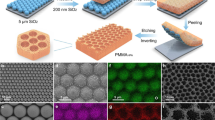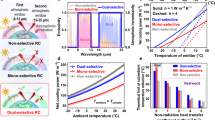Abstract
Traditional cooling systems consume tremendous amounts of energy and thus aggravate the greenhouse effect1,2. Passive radiative cooling, dissipating an object’s heat through an atmospheric transparency window (8–13 μm) to outer space without any energy consumption, has attracted much attention3,4,5,6,7,8,9. The unique feature of radiative cooling lies in the high emissivity in the atmospheric transparency window through which heat can be dissipated to the universe. Therefore, for achieving high cooling performance, the design and fabrication of selective emitters, with emission strongly dominant in the transparency window, is of essential importance, as such spectral selection suppresses parasitic absorption from the surrounding thermal radiation. Recently, various materials and structures with tailored spectrum responses have been investigated to achieve the effect of daytime radiative cooling6,7,8,10,11,12,13,14,15. However, most of the radiative cooling materials reported possess broad-band absorption/emission covering the whole mid-infrared wavelength11,12,13,14,15. Here we demonstrate that a hierarchically designed polymer nanofibre-based film, produced by a scalable electrostatic spinning process, enables selective mid-infrared emission, effective sunlight reflection and therefore excellent all-day radiative cooling performance. Specifically, the C–O–C (1,260–1,110 cm−1) and C–OH (1,239–1,030 cm−1) bonding endows the selective emissivity of 78% in 8–13 μm wavelength range, and the design of nanofibres with a controlled diameter allows for a high reflectivity of 96.3% in 0.3–2.5 μm wavelength range. As a result, we observe ~3 °C cooling improvement of this selective thermal emitter as compared to that of a non-selective emitter at night, and 5 °C sub-ambient cooling under sunlight. The impact of this hierarchically designed selective thermal emitter on alleviating global warming and temperature regulating an Earth-like planet is also analysed, with a significant advantage demonstrated. With its excellent cooling performance and a scalable process, this hierarchically designed selective thermal emitter opens a new pathway towards large-scale applications of all-day radiative cooling materials.
This is a preview of subscription content, access via your institution
Access options
Access Nature and 54 other Nature Portfolio journals
Get Nature+, our best-value online-access subscription
$29.99 / 30 days
cancel any time
Subscribe to this journal
Receive 12 print issues and online access
$259.00 per year
only $21.58 per issue
Buy this article
- Purchase on Springer Link
- Instant access to full article PDF
Prices may be subject to local taxes which are calculated during checkout




Similar content being viewed by others
Data availability
All relevant data are included in the manuscript and Supplementary Information. More detailed protocols, calculations and analysis are available from the authors upon request.
References
Walther, G. R. et al. Ecological responses to recent climate change. Nature 416, 389–395 (2002).
Cook, B. I., Smerdon, J. E., Seager, R. & Coats, S. Global warming and 21st century drying. Clim. Dyn. 43, 2607–2627 (2014).
Catalanotti, S. et al. The radiative cooling of selective surfaces. Sol. Energy 17, 83–89 (1975).
Granqvist, C. G. & Hjortsberg, A. Radiative cooling to low temperatures: general considerations and application to selectively emitting SiO films. J. Appl. Phys. 52, 4205–4220 (1981).
Gentle, A. & Smith, G. Radiative heat pumping from the earth using surface phonon resonant nanoparticles. Nano Lett. 10, 373–379 (2010).
Rephaeli, E., Raman, A. & Fan, S. Ultrabroadband photonic structures to achieve high-performance daytime radiative cooling. Nano Lett. 13, 1457–1461 (2013).
Raman, A. P., Anoma, M. A., Zhu, L., Rephaeli, E. & Fan, S. Passive radiative cooling below ambient air temperature under direct sunlight. Nature 515, 540–544 (2014).
Zhao, D. et al. Radiative sky cooling: fundamental principles, materials, and applications. Appl. Phys. Rev. 6, 021306 (2019).
Li, W. & Fan, S. Radiative cooling: harvesting the coldness of the universe. Opt. Photon. News 30, 32–39 (2019).
Chen, Z., Zhu, L., Raman, A. & Fan, S. Radiative cooling to deep sub-freezing temperatures through a 24-h day–night cycle. Nat. Commun. 7, 13729 (2016).
Goldstein, E. A., Raman, A. & Fan, S. Sub-ambient non-evaporative fluid cooling with the sky. Nat. Energy 2, 17143 (2017).
Zhai, Y. et al. Scalable-manufactured randomized glass-polymer hybrid metamaterial for daytime radiative cooling. Science 355, 1062–1066 (2017).
Li, T. et al. A radiative cooling structural material. Science 364, 760–763 (2019).
Mandal, J. et al. Hierarchically porous polymer coatings for highly efficient passive daytime radiative cooling. Science 362, 315–318 (2018).
Zhou, L. et al. A polydimethylsiloxane-coated metal structure for all-day radiative cooling. Nat. Sustain. 2, 718–724 (2019).
Drury, J. L. & Mooney, D. J. Hydrogels for tissue engineering: scaffold design variables and applications. Biomaterials 24, 4337–4351 (2003).
Wang, H. et al. Graphene-wrapped sulfur particles as a rechargeable lithium–sulfur battery cathode material with high capacity and cycling stability. Nano Lett. 11, 2644–2647 (2011).
Liu, T. et al. Drug delivery with PEGylated MoS2 nano-sheets for combined photothermal and chemotherapy of cancer. Adv. Mater. 26, 3433–3440 (2014).
Li, D., Babel, A., Jenekhe, S. A. & Xia, Y. Nanofibers of conjugated polymers prepared by electrospinning with a two‐capillary spinneret. Adv. Mater. 16, 2062–2066 (2004).
Yang, D., Lu, B., Zhao, Y. & Jiang, X. Fabrication of aligned fibrous arrays by magnetic electrospinning. Adv. Mater. 19, 3702–3706 (2007).
Hu, X. et al. Electrospinning of polymeric nanofibers for drug delivery applications. J. Control. Release 185, 12–21 (2014).
Liu, M. et al. A review: electrospun nanofiber materials for lithium–sulfur batteries. Adv. Funct. Mater. 29, 1905467 (2019).
Wang, Y., Wang, S. & Lou, X. W. Dispersed nickel cobalt oxyphosphide nanoparticles confined in multichannel hollow carbon fibers for photocatalytic CO2 reduction. Angew. Chem. Int. Ed. 58, 17236–17240 (2019).
Han, K. S. et al. Electrically activated ultrathin PVDF‐TrFE air filter for high‐efficiency PM1.0 filtration. Adv. Funct. Mater. 29, 1903633 (2019).
Zhao, D. et al. Subambient cooling of water: toward real-world applications of daytime radiative cooling. Joule 3, 111–123 (2019).
Manney, G. L. et al. Unprecedented Arctic ozone loss in 2011. Nature 478, 469–475 (2011).
Munday, J. N. Tackling climate change through radiative cooling. Joule 3, 2057–2060 (2019).
Stephens, G. L. et al. An update on Earth’s energy balance in light of the latest global observations. Nat. Geosci. 5, 691–696 (2012).
Seager, S. The search for extrasolar Earth-like planets. Earth Planet. Sci. Lett. 208, 113–124 (2003).
Kaltenegger, L., Sasselov, D. & Rugheimer, S. Water-planets in the habitable zone: atmospheric chemistry, observable features, and the case of Kepler-62e and -62f. Astrophys. J. Lett. 775, 1384–1395 (2013).
VPL Spectral Explorer. NASA Astrobiology Institute Virtual Planetary Laboratory http://depts.washington.edu/naivpl/content/vpl-spectral-explorer (2012).
Vladilo, G., Silva, L., Murante, G., Filippi, L. & Provenzale, A. Modeling the surface temperature of Earth-like planets. Astrophys. J. Lett. 804, 50 (2015).
Acknowledgements
We thank the micro-fabrication centre of National Laboratory of Solid State Microstructures (NLSSM) for technical support. This work is jointly supported by the National Key Research and Development Program of China (no. 2017YFA0205700), National Natural Science Foundation of China (nos 52002168, 51925204, 11874211 and 61735008) and Natural Science Foundation of Jiangsu Province (no. BK20190311). W.L. and S.F. acknowledge the support of US Department of Energy grant no. DE-FG-07ER46426.
Author information
Authors and Affiliations
Contributions
B.Z. and J.Z. conceived and designed the project. D.L., X.L., J.L. and B.L. performed the material preparation and characterization. D.L., X.L. and W.L. contributed to the optical and thermal measurement and analysis. W.L., Z. Lin and Z. Li performed the calculations. All authors contributed to the writing of the manuscript.
Corresponding authors
Ethics declarations
Competing interests
The authors declare no competing interests.
Additional information
Peer review information Nature Nanotechnology thanks the anonymous reviewers for their contribution to the peer review of this work.
Publisher’s note Springer Nature remains neutral with regard to jurisdictional claims in published maps and institutional affiliations.
Supplementary information
Supplementary Information
Supplementary Figs. 1–11 and Discussion.
Supplementary Video
The process of roll-to-roll electrospinning es-PEO film.
Rights and permissions
About this article
Cite this article
Li, D., Liu, X., Li, W. et al. Scalable and hierarchically designed polymer film as a selective thermal emitter for high-performance all-day radiative cooling. Nat. Nanotechnol. 16, 153–158 (2021). https://doi.org/10.1038/s41565-020-00800-4
Received:
Accepted:
Published:
Issue Date:
DOI: https://doi.org/10.1038/s41565-020-00800-4
This article is cited by
-
A dual-selective thermal emitter with enhanced subambient radiative cooling performance
Nature Communications (2024)
-
Electrospinning of nanofibres
Nature Reviews Methods Primers (2024)
-
Nonreciprocal thermal photonics
Nature Photonics (2024)
-
Superhydrophobic daytime radiative cooling coating incorporated with phase change microcapsules for building thermal regulation
Journal of Materials Science (2024)
-
Solvent-free fabrication of mechanically durable superhydrophobic film with regular hollow structures for passive cooling
Journal of Materials Science (2024)



